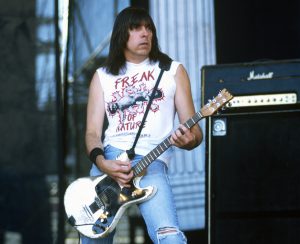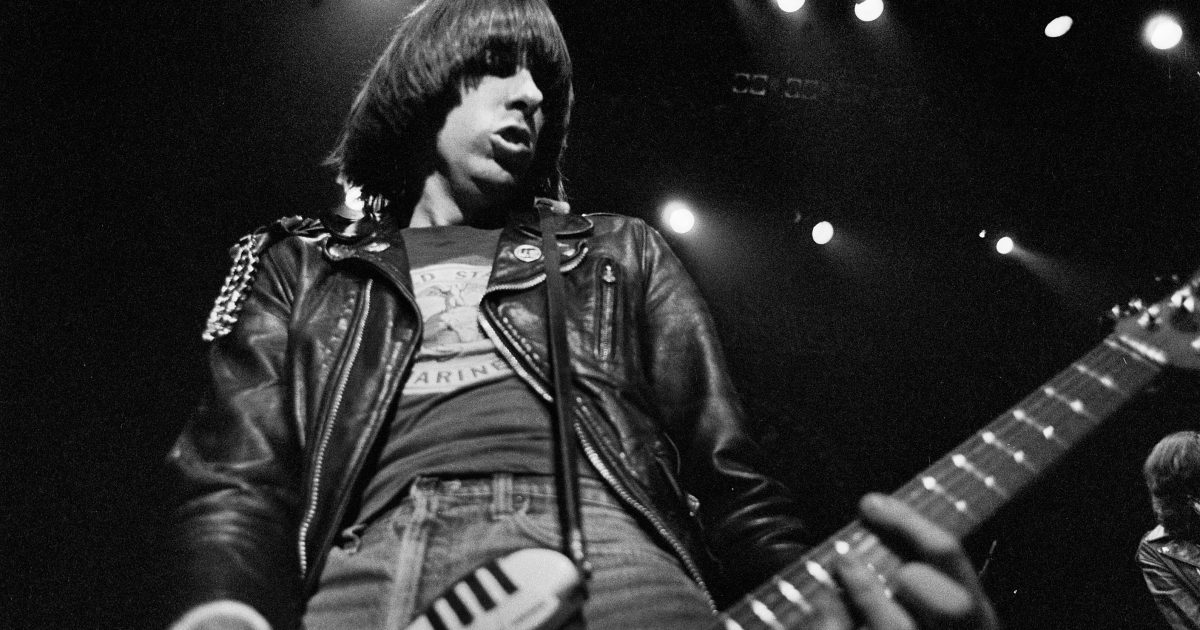Remembering Johnny Ramone, Iconic Punk Rock Guitarist-- 'Appealed To All The Misfits Of Society'
- Johnny Ramone died of prostate cancer on September 15, 2004, after a five-year battle with the disease that eventually spread throughout his body. He was 55.
- But the founding member of iconic punk rock band the Ramones maintains his influence on music today with many artists imitating the aggressive, punctuated style of guitar playing that Johnny perfected.
- Prostate cancer is the most common cancer in American men. Symptoms of prostate cancer are inconsistent and hard to pinpoint but may include changes in urinary function like urinating more or less often or waking up at night to go more than usual.
- There are treatment options available for people facing late-stage prostate cancer. In fact, an oral medication called Nubeqa (darolutamide) was just approved by the Food and Drug Administration (FDA) in August 2022 for use in combination with Taxotere (docetaxel) for adult patients with metastatic hormone-sensitive prostate cancer (mHSPC).
- Nubueqa is in a category of anti-androgens or anti-testosterone drugs, and it works by blocking the effects of testosterone to slow the growth and spread of prostate cancer.
John William Cummings, better known by his stage name Johnny Ramone, had been battling prostate cancer for five years before his death.
Read MoreThe Legacy of Johnny Ramone
Johnny Ramone was a hugely prominent figure in the world of punk rock. He was the guitarist and founding member of the Ramones a band that helped pioneer the punk movement.
Akin to Johnny’s style of playing, his intro to the industry was anything but a slow wading into the waters of music. It was more like a head-first dive.

Johnny played bass for garage-rock band the Tangerine Puppets in the late 1960’s, but he eventually switched instruments early in 1974. That very same year, he founded the Ramones and learned to play guitar at age 26 after being laid off from a long-term construction job. His original bandmates were Jeffrey Hyman, Douglas Colvin and Tom Erdelyi, but they, too, were better known by their stage names Joey Ramone, Dee Dee Ramone and Tommy Ramone.
Once the Queens, New York, band of friends was formed, the “group of glue-sniffing delinquents” turned aggressive punk rockers quickly made a name for themselves. Though they never had a hit single or a gold record, their biggest songs like “Blitzkreig Bop” and “I Wanna Be Sedated” still make the rounds today.
And the group’s successful career that granted them members of the Rock and Roll Hall of Fame in 2002 was highly attributable to the driving force that was Johnny Ramone.
“They carved out that 22-year career mostly on Johnny’s willpower,” Christopher J. Ward, a bass player who joined the band in 1989 as C.J. Ramone, told The Washington Post. “He made sure they kept touring, he decided the pace of the set and what songs would be played. He made it happen.”

After conducting a handful of interviews with Johnny over a 20-year period, veteran music critic Jim Farber called him “a straight shooter with a deadpan sense of humor and a severe disinterest in idealizations about life or people.” But that hardened nature makes sense given the style of guitar playing that he branded for himself a violent, accelerated expression of power-chord playing. Johnny, himself, once described his style as “pure, white rock ‘n’ roll, with no blues influence.”
“I wanted our sound to be as original as possible,” he said. “I stopped listening to everything.”
But others did not stop listening to him. And you’d likely be hard-pressed to find a contemporary punk guitarist who denies Johnny’s influence on their own playing.
“What self-respecting punk guitarist hasn’t wanted to play like Johnny Ramone?” Farber wrote in 2004. “And who has ever played faster, or tougher, or come up with so many blisteringly fleet riffs?”

In fact, the influence of the band in its entirety cannot be overstated something the lead singer of Pearl Jam, Eddie Vedder, made sure to note following Johnny’s untimely death.
“They influenced so many people,” Vedder said. “They showed them that they too could do it. The simplicity showed them that they could end up on stage and play in that way.”
But Johnny himself, perhaps, summed up the legacy of his band best during an interview with Guitar Player magazine in 2003.
“We didn’t sell a lot of records, but somehow we left an impression,” Johnny said. “We just wrote good pop songs, tried not to compromise, and we put on a good show. Somehow, we appealed to all the misfits of society.”
Understanding Prostate Cancer
Prostate cancer is the most common cancer in American men except for skin cancers. About one in eight men will be diagnosed with this disease during his lifetime. The disease begins in the walnut-shaped prostate gland located between the rectum and bladder. This gland produces the fluid that nourishes sperm.
When Should I Get Tested for Prostate Cancer?
Symptoms of the disease are generally inconsistent and hard to pinpoint.
"Prostate cancer is a very odd disease in that it doesn't have a particular symptom," Dr. Edwin Posadas, director of translational oncology and the medical director of the Urologic Oncology Program at Cedars-Sinai, explained.
But changes in urinary function like urinating more or less often or waking up at night to go more than usual could be a sign of the disease. However, it's important to note that these potential symptoms could also could be caused by a urinary tract infection or even an enlargement of the prostate gland (which is not cancer). Still, you should always consult a medical professional if any changes to your health arise.
There's No One Definitive Symptom for Prostate Cancer, But There Are Clues
Doctors who have spoken with SurvivorNet shared a hopeful outlook when considering a prostate cancer diagnosis because there are many treatment options and there's been significant treatment progress over the past decade.
Surgical and radiation options, for example, have made improvements in reducing side effects of treatment while still providing excellent cure rates. Even for men with an advanced-stage diagnosis, many new options exist to treat prostate cancer and help them maintain an excellent quality of life.
Hope for Patients with Late-Stage Prostate Cancer
People with late-stage prostate cancer usually undergo some combination of treatments. And new approvals are being made all the time to give people more options to treat this advanced disease.
The drug nubeqa (also known as darolutamide), for instance, was just approved by the Food and Drug Administration (FDA) in August 2022 for use in combination with taxotere (docetaxel) for adult patients with metastatic hormone-sensitive prostate cancer (mHSPC).
RELATED: How Is Nubeqa Used to Treat Advanced Prostate Cancer?
This oral medication is in a category of anti-androgens or anti-testosterone drugs, and it works by blocking the effects of testosterone to slow the growth and spread of prostate cancer.
How Does Androgen Deprivation Therapy Help Shrink Prostate Cancer Tumors?
"If we take away testosterone, we can shrink down the tumor and hold it in check for often years and years and years," Dr. Stephen Freedland, a urologist at Cedars-Sinai Medical Center, previously told SurvivorNet of androgen deprivation therapy in prostate cancer.
RELATED: How to Treat Late-Stage Prostate Cancer: Treatment Developments
Xtandi (enzalutamide) is another androgen deprivation therapy. This oral medication is FDA-approved to treat non-metastatic (nmCRPC) and metastatic castration-resistant prostate cancer (mCRPC) and metastatic castration-sensitive prostate cancer (mCSPC).
Erleada (apalutamide) is another FDA-approved oral medication for advanced prostate cancer. It can be used for people with metastatic castrate-sensitive prostate cancer (mCRPC).
In addition to androgen-depravation drugs, PARP inhibitors can also be a good option for some people with advanced prostate cancer. These drugs work by stopping the activity of poly (ADP-ribose) polymerase, a protein involved in DNA repair. This, in turn, causes DNA to be unable to repair itself in cancer cells and therefore leads to the death of these cancer cells.
The two PARP inhibitors currently approved by the FDA are lynparza (olaparib) and rubraca (rucaparib). They are specifically approved for use in people with metastatic castration-resistant prostate cancer (mCRPC) this distinction means the prostate cancer has spread beyond the prostate and does not respond to hormone therapy.
When Is Hormonal Therapy Used to Treat Prostate Cancer?
Some prostate cancers express the protein PSMA which can be targeted with medication. In March 2022, another FDA approval paved the way for the drug pluvicto (lutetium Lu 177 vipivotide tetraxetan) to treat patients with prostate-specific membrane antigen (PSMA)-positive metastatic castration-resistant prostate cancer (mCRPC).
"The approval of lutetium is a major step in the development of personalized treatment for advanced prostate cancer," Dr. David Penson, of Vanderbilt University Medical Center, told SurvivorNet in a previous interview. "This agent specifically targets PSMA-positive metastasis and represents the first theranostic agent for use in castration-resistant metastatic prostate cancer."
This medication is considered "theranostic" because it combines diagnostic and therapeutic capabilities by identifying the presence of PSMA on a patient's cancer cells and then treating it directly with minimal exposure to normal tissues.
In addition to the above treatments, there are plenty of other options for advanced prostate cancer patients to turn to when dealing with their disease. Talk with your doctor about your options, and consider asking if a clinical trial might be right for you.
Clinical Trials Need More Minority Patients
Learn more about SurvivorNet's rigorous medical review process.


